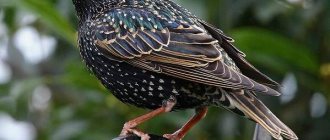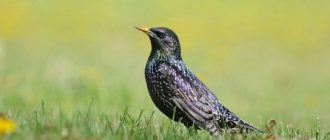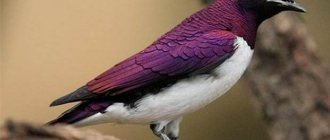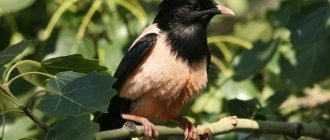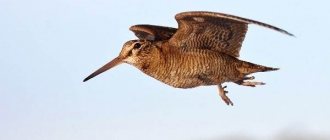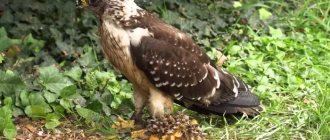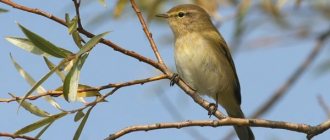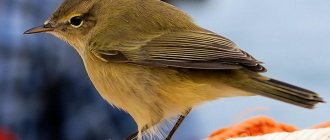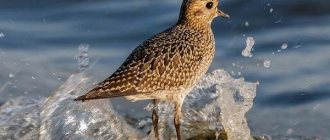The starling is a songbird of the starling family of the order Passeriformes, one of the first to arrive in the spring. It is for starlings that birdhouses are made in order to attract birds closer to cultivated plantings, because the starling feeds on insect pests of the crop. The starling sings beautifully and is easily tamed; he willingly communicates with a person, imitates his voice and intonations.
Starlings are among the first to arrive in spring after larks.
What do birds look like and what is their lifestyle?
The starling is a small bird weighing on average 70 g with long wings and a rectangular tail. All birds have rather dense plumage, mostly dark with a shiny tint, which they change once a year after nesting. After molting, small gray triangular specks appear in the plumage. The male and female have similar colored plumage.
Distinctive characteristics of starlings:
- The bird's beak is very strong, straight or slightly curved.
- The starling is able to deftly pull worms out of the ground with blows of its beak.
- The bird can sit on a branch and move on the ground thanks to the universal structure of its legs.
- Starlings are social birds, keep in flocks and often live in large groups.
- Only a few species are able to build a nest themselves.
- The starling will be more likely to be happy with the finished building and settle in the birdhouse or unceremoniously begin to challenge the hollow occupied, for example, by a woodpecker.
THIS IS INTERESTING. The ancient Slavic word "skver" means imitation of the sounds that a starling makes. The word formed the basis of the Bulgarian “skveret” (shout) and the Ukrainian verb “skvereshchati” (shout loudly).
Common starling
The common starling is a traditional resident of birdhouses. The bird chirps next to a person’s home, masterfully weaving new notes of overheard intonations into its repertoire. The male, 20–25 cm long, wears black, shiny plumage elongated on the chest with a blue, green or purple tint; the female’s plumage is paler in color and has short feathers on the chest. This species is widely distributed throughout Europe and was specially introduced to Australia, North America and South Africa. Only the northern populations fly to the south of Europe for the winter in August - September, the southern populations live sedentary.
Common starlings often live near human dwellings in cities and rural areas
Common starlings often live in flocks in cities and in rural areas near fields, pastures and livestock areas. Nests are made in cracks under roofs, in the hollows of old trees and, of course, in birdhouses. Rural residents specifically attract starlings to protect their gardens from insects and crop pests. The starling destroys enormously overgrown hordes of caterpillars, locusts and slugs.
Common mynah or yellow-eared starling
The mynah genus includes eight species. The common myna is distinguished by islands of yellow skin on the sides of its head, and it also has a yellow beak and yellow legs that contrast with its plumage. The length of the black body with a greenish tint reaches 27 cm. This bird is an indigenous inhabitant of Afghanistan, Central Asia, and India, for which it is called the “Afghan starling.” It was manually introduced into Australia and South Africa and North America. The Afghan starling destroys large numbers of locusts in the fields, but at the same time raids vineyards and berry plantings.
The common myna is useful and destroys locusts, but likes to destroy vineyards
They like to keep mynah in houses because it is easily tamed and is very capable of learning. You could say this is a talking starling. She constantly adds new words and entire phrases to her vocabulary, imitates human intonations, copies meowing and dog barking.
Pastor
The bird is very beautiful: its black and purple head is crowned with a small crest, and its belly and back are painted a delicate pink color. Lives in the southern zone of the European part of Russia, Kazakhstan and southwest Siberia. He likes to settle in dry steppe areas, where there is food in the form of locusts and closer to water. It is a migratory bird and winters in India. By feeding its chicks, the pink starling brings benefits: it destroys a large number of locusts and grasshoppers in the fields. It’s only after the chicks fly out of the nest that his taste preferences change, and the savior of the fields turns into a pest: he pecks out grapes and devastates fruit trees.
The pink starling lives in Kazakhstan and winters in India
For nesting, it will choose a crevice in the rock or use a birdhouse. Pink starlings are very sociable birds and coexist peacefully in a flock: they settle in large colonies, build nests close to each other and even join flocks with crows, sparrows and other species of starlings.
gray starling
A smoky-gray bird 20–23 cm in size. Females have feathers, except for the head, with white tips; males have a crest of black feathers on the head. Yellow-orange legs and beak. The gray starling lives in Transbaikalia and Primorsky Krai, Japan, Korea and China. In the cold season, it moves to the south of China, to Taiwan and feeds in rice fields. Lives in southern Japan all year round. It loves plains and open forests; it cannot be found in dense forests. It readily settles in city gardens and parks, as well as in rural areas.
The gray starling nests in Transbaikalia and the Primorsky Territory, and in winter feeds in rice fields
Gray starlings stay in flocks and also make nests nearby, preferring not to move away from their neighbors. They willingly live in man-made houses. They feed on both plant and animal foods. They eat beetles, ants, worms, spiders; In addition, the gray starling dares to hunt frogs. During the season they like to eat cherries and strawberries, and in winter they peck at the fruits of Persian lilac, laurel and persimmon.
Black-winged Starling
The black-winged starling is a medium-sized songbird up to 22 cm in size with a white body plumage and black wings and tail, and both sexes look the same. This species is native to the tropical islands of Bali and Java. Inhabits flat areas covered with grass: fields, pastures, forest edges. It makes its home in rocks or hollows of local tropical trees. It feeds on the fruits of fruit trees and insects.
The black-winged starling lives in Bali
Yellow-billed buffalo starling
This starling is distinguished by a bright yellow beak with a red ending and red eyes. It has dark gray upperparts and lighter underparts. The bird lives in Africa in the strip from Senegal to Sudan and feeds on insects that live on the skin of large mammals. Starlings follow cows, buffaloes, and wild zebras and giraffes for months at a time. Birds love to grab the fur of these animals to line the bottom of their nests.
African buffalo starling feeds on skin mites and parasites
Amethyst Short-tailed Starling
This is a starling from the tropical fauna of Africa and sub-Saharan Africa. It has a fantastic dark lilac color with a metallic sheen on the feathers of the upper body and sings beautifully. It lives mainly in forests and feeds on tropical fruits. The nest is made in a hollow tree and lined with green leaves. Lives sedentary and does not leave the territory around its native nest.
The feathers of the tropical amethyst short-tailed starling are colored bright lilac.
Red-cheeked Japanese Starling
The homeland of this starling is Japan and China, from where it partially migrated to the south of Sakhalin and the Kuril Islands. Despite the fact that it nests in the subtropics, during the cold season it prefers to move further south: to Taiwan and the Philippines. Japanese starlings choose clearings in sparse forests, as well as the outskirts of cities, for nesting. They often live in city parks in birdhouses built for them. Since only about dozens of pairs of starlings live in the Far East, ornithologists have included the Japanese starling in the List of Rare Birds of this region.
The red-cheeked Japanese starling in Japan is considered a common urban bird of gardens and parks.
Grey-headed Starling
The grey-headed starling is a resident of Indochina. It got its name from the silver-gray feathers on the crown. The upperparts are grey, the belly is reddish. Males and females look the same. Likes to settle in rare forests and groves. This species lives sedentary, sometimes wandering to areas rich in food. Prefers hilly terrain covered with sparse forest. The grey-headed starling's main diet is insects; in addition, the starling eats flower nectar and the fruits of local plants.
The grey-headed starling in India feeds on nectar and fruits of local plants
Red-billed Starling
The Red-billed Starling nests in southern China. It got its name from its red beak, which is especially bright against the background of the gray body and white feathers on the head and belly. In the male, the feathers of these parts of the body are elongated. There are rare black feathers in the tail and on the wings. Females are brown, uniform color. The red-billed starling has fairly large wings with an average body of 21–24 cm. Sometimes migrates to Vietnam and Japan in winter. It chooses woodlands and gardens for housing and likes to stay in large flocks.
The Red-billed Starling got its name from its distinctive appearance.
Horned starling
The starling primarily lives in the grasslands and fields of southern Africa, but its range moves westward and reaches the Arabian Peninsula. The body is gray, and the wings and tail consist of black feathers. Males are distinguished by patches of yellow skin on the sides of the head and under the eyes, on which feathers do not grow. They have long black feathers hanging down the front. Birds feed on insects and plant foods, mainly local grapes, causing damage to crops.
The horned starling has long black feathers hanging under its beak; the older the male, the more of them there are.
Emerald brilliant starling
This exotic species lives on the African savannah and is distinguished by its brilliant green plumage with purple fragments. It chooses bush vegetation for nesting, but can also settle in sparse, low-growing gardens. Loves to eat ants and pecks at local fruits and nuts.
Exotic-colored starling lives in the African savannah
Golden-breasted spreo
Tropical starling from eastern Africa: Kenya, Somalia, Ethiopia. Lives in the savannah, settles in acacia groves and tree hollows. Can catch insects on the fly. It also feeds on snails, spiders, and sometimes lizards.
Golden-breasted sprao eats snails, spiders and dares to attack a lizard
Three-color spreo
Another East African tropical species of starling. Breeds in Ethiopia, Kenya and Tanzania in rocks and trees. It feeds on worms, fruits, pecks wild seeds, and snails. It can be found in the savannah, in the fields, and in cities. Wears elegant plumage of black, turquoise and reddish colors with a glossy sheen. On the chest, a white stripe separates the colored areas. The tricolored spreo is a mockingbird and is adept at imitating the calls of other birds.
East African Tropical Tricolor Spreo adopts the calls of other birds
Appearance and features
Photo: Starling bird
The starling can be easily distinguished from other medium-sized passerines, such as thrushes or funnels. They have a short tail, a sharp beak, a rounded, compact silhouette, and strong reddish legs. In flight, the wings have a sharp shape. The color of the plumage from a distance looks black, but upon closer inspection you can see iridescent shades of violet, blue, green, purple with white rowan spots. The number of white feathers increases in winter.
Video: Starling
On the neck of males the plumage is looser and fluffier, while females have feathers with sharper ends that fit tightly. The paws are gray-reddish, strong, the toes are strong, long with tenacious claws. The beak is sharp, dark brown, in summer it becomes yellow in females, and partially yellow in males with a bluish base. The wings of birds are of medium length with a rounded or pointed tip. The iris of the eyes of males is always brown, and that of females is gray.
Interesting fact: During the winter, the tips of the feathers wear out, and there are fewer white spots; the birds themselves become darker.
Starling parameters:
- in length - 20 - 23 cm;
- wingspan - 30 - 43 cm;
- weight - 60 - 100 g;
- tail length - 6.5 cm;
- beak length - 2 - 3 cm;
- paw length - 2.5 - 3 cm;
- wing chord length - 11 -14 cm.
Birds molt once a year, towards the end of summer, after the breeding season, it is at this time that more white feathers appear. During flight, birds quickly flap their wings or soar for a short time without losing altitude. The whole flock takes off from a place and during the flight they form a common mass or line.
Range and habitat
The starling's range covers almost all continents. It occupies all of Eurasia, except for the areas north of Arkhangelsk. It doesn't exist in Norway either. It even nests in Siberia, but without invading the northern taiga forest. The southern border of the range is Morocco, Egypt and Central Asia, Kazakhstan, northern India, and northwestern China. Some species of starling were specially introduced to southern Africa, North America and Australia.
THIS IS INTERESTING . The experience of relocating the common starling to New York is notorious. Enthusiasts proposed bringing 120 individuals to Central Park so that the starlings would delight the citizens with their singing. The birds, contrary to expectations, were not limited to the park, but spread throughout America from Canada to Mexico and number 200 million individuals, which have significantly squeezed out the habitats of local birds.
Starlings select different habitats depending on the species. Most starlings prefer sparse forests in temperate and tropical zones. Other species nest in steppe and even arid areas, as well as in the savannah. Among starlings there are species that do not leave their native lands. There are starlings that are nomadic and change their place of residence seasonally.
Natural enemies of starlings
Photo: Gray starling
The main enemies of starlings are birds of prey, although these passerines use effective flight tactics in a flock. Their method and pace of flight does not coincide with the flight of birds of prey.
But still, many predators pose a danger to them, these are:
- northern hawk;
- Eurasian sparrowhawk;
- peregrine falcon;
- hobby;
- kestrel;
- eagle;
- buzzard;
- little owl;
- long-eared owl;
- tawny owl;
- barn owl.
In North America, about 20 species of hawks, falcons, and owls pose a threat to the common starling, but the most trouble can be expected from merlins and peregrine falcons. Some birds destroy eggs or chicks of starlings and take them from the nest. Mammals from the mustelid family, raccoons, squirrels, and cats can eat eggs and hunt chicks.
Parasites pose problems for starlings. Research has shown that almost all representatives of the sample made by ornithologists had fleas, ticks, and lice. 95% were infected with internal parasites - worms. The chicken flea and the pale sparrow flea also greatly disturb birds in their nests, but the starlings themselves are partly to blame for this. By capturing other people's nests, they receive them with a full set of contents, including parasites. When a bird dies, the blood-sucking parasites leave the owner to find another.
The louse fly and the saprophagous fly gnaw off the feathers of their host. The shiny scarlet nematode, moving in the host's body from the trachea to the lungs, causes suffocation. Starlings are one of the most parasite-infested birds, as they regularly use their own old nesting sites or occupy other people's homes infested with parasites.
How the starling sings
The starling vocalizes at times of danger, when transmitting signals to relatives or in disputes over territory. At the moment of nervous excitement, the bird cheerfully “chirps.” Call is a short signal of a starling, sounds like “chr-r”. Starling song consists of a wide range of melodic turns, as well as crackles, clicks and other non-musical sounds. The fact is that starlings imitate the sounds they hear: the voices of domestic animals, human speech and the chirping of other birds.
The starling sings the best arias during the mating season, because the fate of his offspring depends on it
THIS IS INTERESTING. Ornithologists who studied the songs of the common starling recognized in them the voices of about 20 species of birds with which it was familiar: oriole, cuckoo, spotted woodpecker, kite, heron, nightingale and others. Another naturalist related an incident in which a starling made sounds similar to the clatter of a typewriter.
Each starling composes an individual repertoire, which includes several songs. The song consists of fragments, each of which the starling can repeat with sounds of different pitches. The starling sings throughout the year. During the mating season, he chooses the location of the future nest and spends hours on end trying, because his variations should please the female. She also sings, but much more modestly, and does not voice at all when she hatches her chicks. The male takes a break only when he changes his plumage.
Listen to the starling's spring song in this video:
Origin of the species and description
Photo: Starling
The starling family Sturnidae is a large group with a diverse set of species. Most of them live in Eurasia and Africa. It is believed that these birds originated and spread around the world from the African continent. The closest to the common species is the nameless starling. This species survived the Ice Age in the Iberian region. The oldest known remains of the common starling date back to the Middle Pleistocene.
The common starling has about twelve subspecies. Some differ from each other insignificantly in size or color variation, or habitat geography. Some subspecies are considered transitional from one to another.
Interesting fact: When migrating, starlings fly at a speed of about 70-75 km per hour and cover distances of up to 1-1.5 thousand km.
These noisy birds sing and make various sounds all year round. Their meaning can be different, in addition to songs, these are cries of threat, attacks, calls for copulation or for a general gathering, alarming cries. Starlings are constantly making noise when they feed or quarrel, they just sit and talk to each other. Their constant hubbub is hard to miss. In cities, they try to occupy any secluded places on balconies, under windows, in attics, creating some problems for people. When flying in a large flock, their wings make a whistling sound that can be heard from several tens of meters away.
Interesting fact: The starling walks or runs on the ground, and does not move by jumping.
How to breed offspring
The male chooses the place for the future home. It must be a closed space of natural or man-made origin. He is the first to arrive after wintering and vigilantly looks out in the area for a hollow, a gap in the rock, a hole on a high river bank, or a depression under a roof. The starling cannot peck at a tree like a woodpecker, so it willingly takes wooden birdhouses offered by humans.
THIS IS INTERESTING. Sometimes the male marks a place for a future nest: he brings a bunch of grass or even a flower, an additional “gallant gesture” so that the female chooses him.
When the nesting site is chosen, the starling begins to perform his best arias, to which the female responds. Ornithologists have found that 50% of males are polygamous and court several females at once, but remain with the very first one. Having become a pair, starlings together build a nest from twigs, straw, grass stems, lining it with bird down and moss.
Hatched yellowthroats can now be left alone while their parents forage for food.
Depending on the region, the female lays her first clutch of eggs from mid-April to mid-May. Common starlings usually have 5–6, maximum 8, pure blue sometimes white eggs, averaging 27 by 19 mm in size. The mynah has fewer of them, from 2 to 5 eggs. The female incubates the clutch for an average of 14 days, leaving briefly to feed. In her absence, the future father does this. During the season, starlings manage to breed twice.
The hatched starlings are barely covered with whitish fluff; they are helpless, but can already be left alone while their parents get food. Both parents do this at the same time. At first, yellowthroat starlings eat only soft caterpillars and worms, but later their parents give them grasshoppers, beetles, and even snails. After 20 days, the chicks are ready to eat on their own, but their parents will take care of them for another five days.
THIS IS INTERESTING. Sometimes adult starlings have to use cunning to encourage yellowthroats to take their first flight, for example, by luring them out of the nest with a tasty morsel.
An adult starling will care for and feed the grown chicks
Role in the ecosystem
The large abundance of starlings makes them an important food source for many small predators. Starlings are able to nimbly conquer new territories due to their high fecundity , polygamy, and ability to exploit a wide range of foods and habitats. This also means that they can have a significant impact on grain, berry and fruit crops and insect populations. In areas where starlings are not native, they often displace native bird species, including sparrows, crayfish, tree swallows and woodpeckers.
What does it eat?
The starling eats insects and plant foods. The spring food of the common starling is insect larvae in thawed areas and the first earthworms. In order to easily obtain food, the birds walk along the fresh furrow when the farmer plows the land, and hang around in the trampled pastures among the animals. And some species, inhabitants of savannas and lovers of ticks and parasites, become companions of large mammals. This is what the yellow-billed buffalo starling does, for example.
At the beginning of summer, the diet is replenished with bugs, spiders, and butterflies. Starlings eat grasshoppers, locusts, caterpillars, and mole crickets, which greatly helps gardeners preserve the future harvest. For example, the common mynah eats 150 thousand insects per year. However, from mid-summer, starlings happily switch to the contents of the gardens and peck at pears, cherries, strawberries, currants and grapes.
THIS IS INTERESTING. The government of Uzbekistan declared war on mynah starlings in 2003. The birds completely destroyed the vineyards. Hunters and activists were called upon to destroy at least 70% of the birds, and ammunition was purchased and distributed free of charge. But the more birds were shot, the more their fertility increased. The authorities were forced to lay down their arms.
In autumn, the starling eats wild seeds of oak, maple, and rowan. With the onset of cold weather, migratory species fly south. If the flocks remaining for the winter lack food, they often fly to landfills and barnyards.
Starlings need plant food, and they are very fond of the fruits of fruit trees.
Nutrition
Starlings are considered omnivorous birds, whose diet includes both plant and animal foods. The following organisms serve as a source of proteins for birds:
- snails;
- caterpillars;
- insect larvae;
- butterflies;
- earthworms;
- grasshoppers;
- spiders;
- symphylos.
In the spring, immediately after the snow melts, starlings find food in thawed areas, in secluded wintering places for insects - in cracks in the bark of trees. With warming, the hunt for arthropods and worms begins.
In plant foods, starlings prefer berries and fruits. There are always a lot of birds in apple and cherry orchards; they will not refuse ripe plums and pears.
It is interesting that birds open the hard skin or shell of nuts according to all the laws of physics - they punch a small hole, insert their beak and unclench the fruit according to the rule of leverage to get to the contents. In addition to juicy fruits, starlings consume plant seeds and grain crops.
Starlings can cause damage to agriculture if huge flocks begin to dominate fields. Heralds of spring are moderately useful for planting, but columns of birds become a threat to the future harvest.
Flight and wintering
Starlings live permanently in Southern and Western Europe and the Caucasus. Starlings of Central and Eastern Europe, as well as Siberia, are migratory birds. Moreover, certain groups of urban starlings, given a sufficient number of places with food waste, prefer to stay at home.
The migration of the bulk of starlings begins in October. They fly away from the northern regions much earlier, in July, immediately after the first litter of offspring. Flocks of starlings fly vast distances; for example, the common starling can withstand flights of up to one and a half thousand kilometers.
The migration of starlings begins in October, and in the north already in mid-July
Starlings winter in North Africa, Egypt, northern Iran and the Arabian Peninsula, and India. The American population of starlings migrates to Mexico. Since starlings are incredibly social, it is not uncommon for migrants to join local flocks.
Starlings are one of the first birds to return home after larks. There is still snow everywhere, the first thawed patches have barely appeared, and the starlings are already singing. Thus, in Sweden and Eastern Europe, starlings can be heard at the end of February, in central Russia - in mid-March, in the northern regions - in early May.
Starlings arrive in the spring after the larks
Character and habits of starlings
Recommended by topic
Owl Moose
Starlings have exceptional sociability towards each other. They always live in large flocks, the nests of which are located nearby. They also prefer to move through the air in a group: synchrony is evident in their hunting, during flight, and even when landing. Already on the ground they are divided into small groups, choosing the most convenient areas.
Starlings can hardly be called friendly birds towards other birds. Although they get along well with members of their own species, other birds are potential competition for them. Therefore, starlings often try to dislodge them from their homes, choosing the best angle for nesting.
Starlings, which have spread across the United States, have gradually displaced red-headed woodpeckers from their usual habitats. Currently, territorial disputes still occur between representatives of these species.
Starlings are very sensitive to protecting their territory and do not allow other birds to approach their home. When offspring appear in the nest, they become especially careful and do not fly far from home. The search for food occurs only in nearby areas.
Natural enemies in the wild
The natural enemies of starlings that live in tree hollows are pine martens, which climb into nests and attack chicks as soon as they begin to grow up. Martens specifically switch from a nocturnal to a diurnal lifestyle at this time. When yellowthroats learn to fly, the predator begins to have a busy time; sometimes it destroys more of them than it can swallow and leaves a reserve for hungry times. Other species of the mustelidae family, as well as squirrels, also attack chicks.
In the sky, the starling is threatened by birds of prey: hawks, falcons and eagles. It is easier for a large flock of starlings to elude the clutches of sky robbers than alone; the outermost birds notice the enemy and transmit a signal to the others. The flock instantly changes direction of flight and then scatters. In addition, magpies, crows and some other large birds can carry eggs from the nest. Ticks and fleas lie in wait in the starlings' nest. These parasites are inherited by starlings from the previous owners of the hollow and wait for them in the downy old litter. Therefore, ornithologists consider starlings to be the most infected of birds.
In the forest, ornithologists prevent predators from accessing the starling's home by wrapping the trunk with polyethylene
Social structure and reproduction
Photo: Starling chick
In starlings, males look for a suitable place for a nest, a hollow, and begin to carry dry and green parts of plants there. They often store aromatic herbs, perhaps to attract mates or to repel parasitic insects. They make preparations, stocking up on building materials for the time when their partner appears. Throughout this time, the males sing songs, fluffing up the feathers on their throats, trying to attract the female. Once the pair is created, they continue to build the nest through joint efforts. Nests are created in tree hollows, artificial birdhouses, hollow stumps, niches in buildings, and rock crevices. The nest itself is created from dry grass and twigs. The inside is lined with feathers, wool, and down. Construction takes approximately five days.
These birds are monogamous; polygamous families are less common. Since starlings prefer to live in large colonies, nests can be located close to each other. In polygamous families, males mate with a second partner while the first one incubates the eggs. In the second nest, reproduction is lower than in the first. The breeding season occurs in spring and summer. The female lays eggs for several days. Most often these are five bluish eggs. Their size is 2.6 - 3.4 cm in length, 2 - 2.2 cm in width. The eggs hatch for two weeks, both parents do this, but the female is always on the nest at night. The chicks appear without feathers and are blind; after a week they begin to have down, and on the ninth day they begin to see. During the first week, parents constantly remove droppings from the nest so that humidity does not affect the condition of the chicks, which do not have good thermoregulation.
The chicks are in shelter for 20 days, all this time they are fed by both parents, even after the young leave the house, the parents continue to feed them for about two weeks. In the north of the range, one brood appears per season, in more southern regions - two or even three. In a flock, females left without a mate can lay eggs in other people's nests. Chicks in colonies can move to neighboring nests, driving other babies out of them. About twenty percent of chicks survive to adulthood, when they are capable of breeding. The lifespan of a bird in nature is three years.
Interesting fact: The longest recorded lifespan of a starling was almost 23 years.
Keeping at home
The starling is tamed faster and more willingly than other songbirds due to its sociable nature. The cage can be placed near a person, for example, on a desk, because the bird is not shy. True, one must be prepared for the fact that the starling will continuously attract the owner to communicate with his chirping and tireless singing.
Starlings can be kept alone or in pairs. The cage for him should be spacious, preferably with wooden bars. Extravagantly shaped cages with decorations, windows or porches should be avoided. The bird feels uncomfortable in them, and the decorative details make it difficult to clean the cage.
The best cage shape is rectangular with a flat top. Cell dimensions in centimeters:
- length - 70;
- width - 35;
- height - 47;
- the clearance between the bars is 1.5.
You need to make several perches inside the cage so that the starling can flit from one to another. Pour clean river sand onto the bottom. The starling swallows it while eating, this helps digest food that birds, unlike animals, do not chew. It is better to place feeders and a container with water higher, so the bird will not be able to cover them with sand.
What to feed a starling in captivity
A starling at home cannot receive the same food as it could get in natural conditions, because it is a complex mixture of insects, fruits and seeds. But in order for the tamed bird to be healthy, it is worth adhering to the feeding rules and giving the starling daily:
- soft food: grated carrots with dried ant larvae, porridge;
- meat: boiled minced meat and mealyworms;
- fruit food: finely chopped apples, berries, grapes, raisins;
- green: oat seedlings;
- natural food: wild fruits and seeds, insects and larvae, which the starling eats in the wild.
Starlings in captivity need fruit, meat, green plant food and natural food.
The diet may vary slightly among different species. For example, myna should be given raw and boiled meat or fish, porridge, white bread, grated carrots and boiled eggs, cottage cheese, as well as daily fruits: apples, raisins and grapes. Tropical cockroaches are a must for her, and in the summer butterflies, grasshoppers and caterpillars.
It is important to know that releasing a domestic starling into the wild means dooming it to death. Over the course of a month of life in captivity, the starling learns to find food and loses its instinct of self-preservation. A starling released into its natural environment will most likely die of starvation or become easy prey for a predator. At home, a starling can live a long time, fifteen or more years.
Reproduction in captivity
Starlings breed in captivity rarely and only if they have enough space for nesting. During the mating season, it is better to keep the couple in a separate large enclosure. When defending the nest territory, the birds will be aggressive. You need to place trunks with hollows, twigs, dry grass and pieces of wool thread in the aviary so that the starlings can make a nest.
Diet
Starlings typically forage for food on the ground. To obtain the necessary food, he has to actively search for it all day . The usual daily food intake exceeds the bird’s own weight by 2–2.5 times.
Such activity and gluttony plays into the hands of gardeners and gardeners. During the summer season, one starling is capable of eating many pests of cultivated plants. According to some estimates, their total mass exceeds its weight by a thousand times.
The bird is especially active in searching for food during breeding and feeding of offspring. On average, a starling visits chicks about 198 times a day. The search radius is up to 500 m from the nest. The “working day” increases to 17 hours a day.
The diet also includes worms, ladybugs, etc. However, the main food is pests:
- mole cricket;
- wireworm;
- slug, etc.
How long do starlings live?
According to research by ornithologists in the Kaliningrad region, the common starling lives in the wild for up to 12 years, and the pink starling for up to 10 years. When well kept in captivity, many starlings live to be 15 and 20 years old.
THIS IS INTERESTING. Hunting starlings for food was common practice for medieval Europeans. Until the 80s of the last century, one could find a delicious starling pate on the shelves of French stores.
The lifespan of a starling in the wild is 10–12 years
Male and female: main differences
Sexual dimorphism in all starling species is rather weakly expressed. So, for example, the male and female common starling differ in the feathers on their chest - in females they are more graceful and shorter. In addition, females have red dots at the base of the beak, while males have a blue spot.
In other species, females and young are slightly lighter than male starlings.
Conservation status of the population
The population of starlings is extremely numerous; various species of birds are spread over almost all continents. However, there are species whose numbers are declining or threatened with extinction. The International Red Book contains:
- Rarotonga starling;
- Balinese mynah;
- black-winged starling.
Extinct species:
- crow aplonis;
- Norfolk starling;
- Buller's starling;
- Mascarene crested starling.
In general, the starling population is not in danger of extinction, so the international Union for the Conservation of Birds has assigned the population the status of “Least Concern.”
Autumn-winter plumage of starlings
At the end of July, looking at the starlings, you can notice their new outfit. In spring and the first half of summer they were almost completely black. Now they have numerous white spots and they have become variegated: the starlings have dressed in their autumn-winter plumage .
At the end of summer, a lot of starlings fly to warmer climes, to the south. Only a few belated starlings linger for a short time. And even in September you can hear their quiet farewell song. Then, in a small flock, they fly over the field, forest and disappear for a long time until next spring, until the future arrival of starlings.
Rating: 4.4/5 — 16 votes
Legends and traditions
Since ancient times, starlings have been used to determine the arrival of spring and the beginning of winter. Spring came into its own with the arrival of starlings. “The April starling is the messenger of spring. The birdhouse is singing, spring is coming,” say popular proverbs. And with the flight of starlings to southern countries, one could expect changes in the weather and imminent cold weather. If a starling settled near a house, they said that this was a good sign and would bring prosperity. It was noted that a starling that sat on the window brought good news.
Starling - a harbinger of heat and cold
THIS IS INTERESTING. Starlings have a built-in barometer for cold weather. Starlings return from wintering in the first rows. But if the cold returns, they can turn south to wait until it warms up.
- The ancient Hindus attracted myna starlings to their homes by making houses for them from dried gourds.
- In Europe, clay houses were made for birds, similar to a round jug with a side hole. There is an old engraving from the 17th century that shows such a house and a starling next to it.
- Later in Europe, a not very humane method of obtaining starling eggs took root using houses hung near the home. Wild starlings occupied the houses, and after the first clutch the owner took the eggs for himself.
- In Eastern Siberia, it was customary for the ancient Buryats to hang a birdhouse right in the yurt, under the ceiling. A bird that settled in such a house promised good luck and prosperity to the whole family.
- The starling in mythology symbolizes spring, sun, warmth, and the joy of new life.
In Rus', the custom of attracting birds to human settlements had a different meaning. Birds cleared crops and gardens of pests. Starling houses, similar to real huts, were made of wood at the beginning of spring and decorated with intricate carvings. The first wooden dwellings were, of course, occupied by starlings, so the houses began to be called birdhouses.
THIS IS INTERESTING. In Sergiev Posad, at the Matryoshka Museum, visitors are shown amazing birdhouses carved from wood in the shape of a man and a woman. The figurines have large mouths through which starlings must fly into their large heads to build a nest there. The figurines look very funny. Historians have found out that such birdhouses were carved by craftsmen for the amusement of the entire village.
Meaning to people
Photo: Enric LLao Sanchez
Starling is beneficial to farmers because it regulates pests that harm crops. In addition, the European starling is also useful as a food source for some animals of the Mediterranean Sea.
On the other hand, the starling is a sworn enemy for the environment and people because they:
- damage agricultural crops and berry crops;
- aggressively crowd out competitors, which leads to a decrease in bird diversity in the region;
- pollute buildings with their excrement, corroding stone and metals and creating a danger to human health due to exposure to pathogenic fungi;
- carry human diseases such as blastomycosis, measles and histoplasmosis;
- cause plane crashes by wandering onto airport runways. The starlings clog the engines, causing them to stop and then the plane to dive.
Relationships of the starling with other fauna and humans
Now you know what a starling is like in life. It would be useful to learn about his relationships with humans, other birds and animals. For example, they can be very happy to be near a ferret and eat food with it. In their colonies, these birds do not tolerate strangers.
The starling brings benefits to humans by saving green spaces from insects. Flocks of birds fertilize the soil well with their droppings. In spring, starlings wander through the fields along with rooks. Since ancient times, people, knowing what a starling looks like and what its size is, have made birdhouses so that the birds can live comfortably. They take great care of their offspring and always bring food to the nest for the chicks.
Damage to agriculture
In Russia, starlings are often found in the courtyards of houses. The owners, knowing what starlings look like, admire them. The singing of this bird delights the human ear. By nature, starlings are very trusting and brave. In midsummer, young birds fly out of their nests and begin to roam the meadows in noisy flocks. In the autumn period from mid-September to early October, the migration of starlings begins. Many of them fly away in early November, when the first snow falls. For the winter, solitary starlings and small flocks of them remain in the warm pre-winter conditions. During this period, their mass accumulation can become a serious threat to agriculture. They begin to peck berries and eat grain crops, thereby causing significant economic damage.
